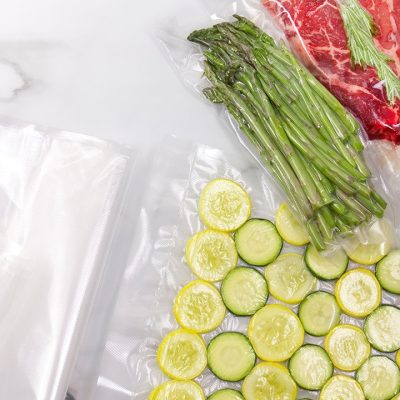Why Choose Vacuum Seal Bags?
Understanding why vacuum seal bags are so popular is key to appreciating their value. The vacuum sealing process removes air from the bag, creating an environment that is hostile to bacteria and mold. This not only extends the shelf life of food but also preserves its flavor, texture, and nutritional value better than traditional storage methods like refrigeration or freezing alone. While these methods are effective, they cannot entirely eliminate the presence of oxygen, which is where vacuum sealing truly excels.
Types of Foods Best Suited for Vacuum Seal Bags
- Meat and Seafood: One of the most common uses for vacuum seal bags is in the preservation of meat and seafood. These protein-rich foods are particularly prone to oxidation and spoilage when exposed to air. Vacuum sealing them reduces the risk of freezer burn, which is a common issue when storing meat for long periods. By removing the air, vacuum seal bags help maintain the quality and flavor of the meat, whether it’s beef, pork, chicken, or seafood like fish, shrimp, and crab. This method is especially beneficial for those who buy meat in bulk or want to prepare meals ahead of time.
- Vegetables and Fruits: While fruits and vegetables contain a high amount of water, many of them can still benefit from being stored in vacuum seal bags. For example, vacuum sealing can prevent apples, pears, and bananas from oxidizing and turning brown, thereby extending their freshness. Vegetables such as carrots, broccoli, and cauliflower can also be vacuum sealed to maintain their crunchiness and nutritional value. However, it’s important to note that certain high-moisture vegetables and fruits, like lettuce and berries, might not be the best candidates for vacuum sealing as they can be crushed or lose their texture in a vacuum environment.
- Dry Goods and Nuts: Dry goods such as dried mushrooms, rice, pasta, and flour, as well as nuts like almonds, walnuts, and peanuts, are excellent candidates for vacuum seal bags. These items tend to absorb moisture from the air, which can lead to spoilage or loss of flavor. Vacuum sealing them helps maintain their crispness and freshness by keeping out moisture and air, which can cause them to go stale. This is particularly useful for those who live in humid climates or want to store bulk quantities for long periods.
- Coffee Beans and Tea Leaves: Coffee beans and tea leaves are highly sensitive to air and moisture. When exposed to these elements, they can quickly lose their flavor and aroma. Vacuum seal bags provide an excellent solution by keeping these items fresh and aromatic for longer periods. This is especially important for gourmet coffee drinkers and tea enthusiasts who seek to preserve the delicate flavors of their favorite brews.
- Grains and Legumes: Grains such as rice, wheat, and barley, as well as legumes like lentils, beans, and chickpeas, are also well-suited for vacuum seal bags. These foods are prone to insect infestations and moisture absorption, which can lead to spoilage. Vacuum sealing not only protects them from pests but also helps maintain their quality by preventing moisture from getting in. This is an ideal storage method for anyone looking to store grains and legumes for an extended period, especially in areas with fluctuating humidity levels.
Tips for Using Vacuum Seal Bags Effectively
While vacuum seal bags are suitable for a wide range of foods, there are some important considerations to keep in mind to ensure the best results:
- Moisture Content: High-moisture foods like lettuce and certain berries may not fare well in vacuum seal bags as they can be crushed or lose texture under the pressure of a vacuum. It’s often best to either avoid vacuum sealing these items or pre-freeze them slightly to retain their shape before sealing.
- Pre-treatment: Some foods require pre-treatment before vacuum sealing. For example, blanching vegetables like broccoli or carrots before sealing can kill surface bacteria and help retain their color and texture. Similarly, portioning meat before sealing can make future meal preparation easier and more convenient.
- Storage Environment: Even with vacuum seal bags, the storage environment plays a crucial role in maintaining food quality. Storing vacuum-sealed items in a refrigerator or freezer can further extend their shelf life and prevent temperature fluctuations from affecting the food.
Conclusion
Vacuum seal bags are an incredibly versatile and effective tool for modern food storage. From meats and seafood to vegetables, fruits, dry goods, and even coffee beans, a wide range of foods can benefit from vacuum sealing. By understanding which foods are best suited for this method and following the proper steps for sealing and storage, you can greatly extend the freshness and quality of your food, reduce waste, and enjoy the convenience that vacuum sealing offers.
If you haven’t tried using vacuum seal bags yet, now is the perfect time to start. Whether you’re looking to preserve large quantities of food or simply want to ensure that your pantry staples stay fresh, vacuum seal bags can provide a reliable solution that meets your needs.
Vous souhaitez en savoir plus sur nos solutions d’emballage souples ? Contactez-nous ! Nous serons ravis de vous conseiller et de vous aider à trouver l’emballage ideal pour vos produits.



